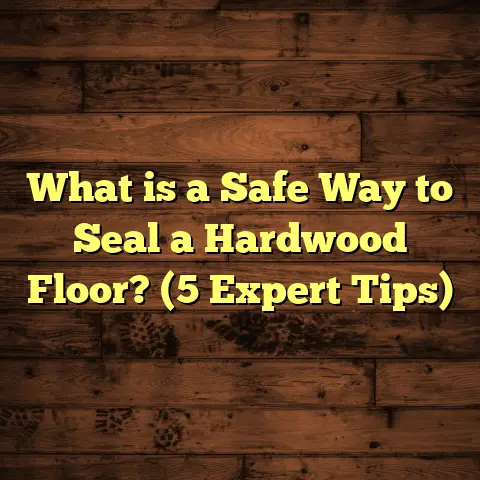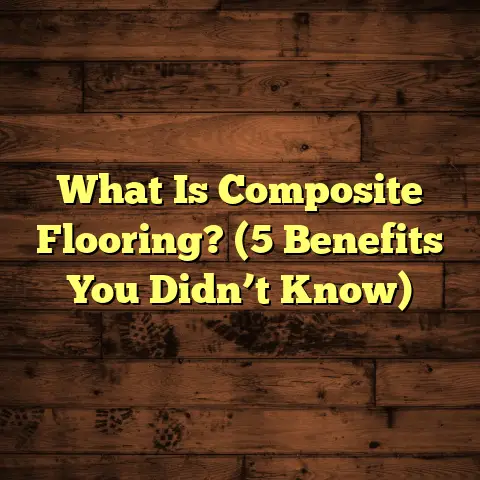What is Artificial Wood Flooring? (5 Key Benefits Uncovered)
I still remember the day I decided to replace the worn-out flooring in my living room. The old hardwood was scratched, stained, and frankly, a pain to maintain. I wanted something that looked great, felt warm, and could stand up to daily life without demanding constant upkeep. That’s when I stumbled upon artificial wood flooring, and it completely changed how I think about flooring options.
At first, I was skeptical. How could something artificial possibly compare to the real deal? But after diving into the options, talking to flooring experts, reading through reviews, and ultimately installing it myself, I realized artificial wood flooring isn’t just a cheaper knockoff. It’s a smart choice for many homeowners — including those who want style, durability, and value all in one package.
What is Artificial Wood Flooring?
Artificial wood flooring refers to a group of floor coverings designed to imitate the look and feel of natural hardwood but made from synthetic or engineered materials. Unlike traditional hardwood, which comes from solid wood planks cut from trees, artificial wood floors use materials like vinyl, laminate, or engineered composites. These materials are crafted to replicate wood’s natural grain patterns, textures, and colors.
You might ask: why choose artificial wood flooring over real hardwood? The answer lies in a combination of factors: cost savings, easier maintenance, installation flexibility, and durability — especially in areas where real wood would struggle.
From my experience, artificial wood flooring is not about sacrificing beauty or comfort; it’s about getting the best of both worlds. You get floors that look stunning while being tough enough for everyday life. Plus, the range of styles available today means you can find everything from rustic oak looks to sleek modern walnut finishes.
To give you a clearer picture, here’s a quick rundown of common types of artificial wood flooring:
- Laminate Flooring: Composed of multiple layers with a photographic wood image under a tough wear layer. It’s affordable and scratch-resistant.
- Luxury Vinyl Planks (LVP): Made from PVC vinyl layers with high-quality printing for realistic wood textures. Waterproof and flexible.
- Engineered Wood: Real wood veneer layered over plywood or fiberboard; combines natural wood look with enhanced stability.
Each has its pros and cons depending on your needs and budget. I’ll share more on this as we explore the benefits.
1. Durability That Keeps Up With Busy Lives
One of the biggest advantages I found with artificial wood flooring is how well it stands up to everyday wear and tear. If you have kids running around or pets with sharp claws, you know how quickly floors can get scratched or dented.
When I had my old hardwood floors, even a small accident like dropping keys or moving furniture left visible marks. After switching to a high-quality laminate with an aluminum oxide protective layer, those worries disappeared.
What makes these floors so durable?
Laminate floors are built with a tough wear layer made from aluminum oxide particles — the same substance used in sandpaper but finely ground and embedded into the surface. This gives laminate floors a resistance to scratches that can be 3-5 times better than typical hardwood finishes.
Luxury vinyl planks also excel here because they are waterproof and resistant to dents and stains. Vinyl’s plastic composition makes it flexible yet strong enough to handle spills and impacts without damage.
Here’s a data point from the National Wood Flooring Association (NWFA):
Laminate flooring typically scores between 6-8 on the Janka hardness scale equivalent testing, whereas many hardwood species range from 3-7 depending on type. This means laminate can be tougher than many popular woods like pine or red oak.
In practical terms, my dog loves chasing his toys around the house. Before the upgrade, his nails scratched deep grooves into the hardwood. Now, after years with artificial wood floors, I see no visible wear.
Are there any caveats?
While durable, not all artificial floors are created equal. Some cheaper laminates or vinyl planks use thinner wear layers that wear out faster. When shopping, look for products with at least 12-20 mil thick wear layers for vinyl or AC3-AC5 ratings for laminate (AC = Abrasion Class).
2. Cost-Effective Without Sacrificing Style
Money matters — I get it. Hardwood floors are beautiful but often come with hefty price tags for materials and installation.
When planning my renovation budget, I compared costs extensively:
| Flooring Type | Average Installed Cost (per sq ft) |
|---|---|
| Solid Hardwood | $8 – $15 |
| Engineered Hardwood | $6 – $12 |
| Laminate Flooring | $2 – $5 |
| Luxury Vinyl Plank (LVP) | $2 – $6 |
These prices include materials plus professional installation where applicable.
A case study published by This Old House tracked three families upgrading their floors using different materials. Those who chose high-end laminate flooring saved approximately 40% on total costs compared to solid hardwood while maintaining similar aesthetics.
For me personally, these savings were a game-changer. I could afford wider plank styles and even splurge on upgraded underlayment for soundproofing without blowing my budget.
Tip: If you want a high-end look but need to save money, focus your budget on the visible surfaces and invest in quality underlayment or subfloor prep rather than exotic woods or expensive finishes.
3. Easy Installation — You Can Do It Yourself
Here’s something I didn’t expect: installing artificial wood floors can be surprisingly straightforward. Unlike hardwood that often requires nailing or glue-down methods needing special tools and skills, most artificial floors come in click-lock systems that snap together like puzzle pieces.
When my friend Mike decided to redo his living room floor with laminate planks, he did everything himself over a weekend. He said it was “easier than assembling IKEA furniture.” The process involves:
- Preparing the subfloor — making sure it is clean, level, and dry.
- Laying an underlayment — this reduces noise and adds moisture protection.
- Clicking planks together — starting from one corner and working across the room.
- Adding trim and transitions — for a polished finish.
The floating floor installation method means no nails or glue are needed; the floor “floats” above the subfloor and can expand or contract slightly with humidity.
In contrast, hardwood installation can take days and usually requires professional help because it involves precise nailing patterns and sanding afterward.
According to HomeAdvisor data:
- Professional hardwood installation costs average $4-$8 per square foot.
- Laminate or vinyl plank installation ranges from $2-$4 per square foot.
If you’re handy with tools or want a weekend project, artificial wood flooring gives you that option to save on labor costs.
Pro Tip: Always acclimate your flooring materials in the room for 48 hours before installation to prevent expansion issues later.
4. Low Maintenance That Fits Your Lifestyle
If you’re tired of spending time polishing, refinishing, or carefully cleaning your floors after every spill like I was, artificial wood flooring offers huge relief here.
Real hardwood floors require regular upkeep:
- Polishing every few months.
- Refinishing every 7-10 years depending on wear.
- Using special cleaners to protect finishes.
With artificial flooring—especially laminate and luxury vinyl—maintenance is as simple as sweeping regularly and mopping occasionally with water and mild soap.
My routine involves:
- Daily dry sweeping using microfiber dust mop.
- Weekly damp mopping with a solution recommended by the manufacturer.
- Wiping up spills immediately but not worrying about long-term stains.
This approach keeps my floors looking new even after years of heavy use.
Research from Floor Focus Magazine highlights: Maintenance costs for hardwood refinishing average $200-$400 every few years, while laminate and vinyl floors require no refinishing costs at all over their lifespan (typically 15-25 years).
This translates into thousands of dollars saved over time just in maintenance alone.
Quick Cleaning Tip: Avoid steam mops on laminate as excessive moisture can cause warping; stick to damp mops instead.
5. Eco-Friendly Options Are Increasingly Available
When I first thought of artificial wood flooring, “eco-friendly” wasn’t top of mind—I assumed synthetic meant less natural and more wasteful. But that’s changed a lot in recent years.
Many manufacturers now focus on sustainability by:
- Using recycled materials in production.
- Avoiding toxic chemicals like formaldehyde.
- Designing products that are recyclable at end-of-life.
- Obtaining certifications like FloorScore or GREENGUARD for indoor air quality.
For example:
- Some laminates use recycled wood fibers from sawmill scraps combined with non-toxic binders.
- Vinyl plank producers offer phthalate-free options with recyclable backing layers.
- Bamboo-based engineered woods come from rapidly renewable resources harvested every 5 years vs decades for traditional hardwoods.
According to data from the Floor Covering Institute: Sales of eco-certified flooring products have increased by 20% annually over the last five years.
In my case, I prioritized brands transparent about environmental impact—checking labels carefully for VOC emissions and recycled content percentages.
If going green matters to you too, ask your supplier for product environmental declarations (PEDs) or third-party certifications before buying.
Beyond The Basics: Additional Insights From My Journey
How Artificial Wood Flooring Handles Moisture
One of my biggest surprises was how well artificial wood flooring performs in moisture-prone areas where hardwood normally fails—like kitchens and bathrooms.
Traditional hardwood swells and warps when exposed to water over time because it absorbs moisture into its cellular structure. That’s why installing hardwood in bathrooms is generally discouraged.
Artificial floors like luxury vinyl plank are waterproof because they’re made primarily from plastic composites impervious to water damage. Even laminate has water-resistant options now with enhanced core boards designed to repel moisture.
I installed LVP in my kitchen and bathroom without hesitation—no worries about spills or steam ruining the floor beneath sinks or next to bathtubs. Years later, it looks flawless.
Sound Absorption & Comfort Underfoot
A well-installed artificial wood floor feels good underfoot and minimizes noise better than some hard surfaces like tile.
During my renovation research phase, I learned the importance of underlayment beneath floating floors—not only does it help with moisture control but also cushions footsteps and reduces sound transmission between floors.
I chose a dense foam underlayment rated for sound absorption (around 60 STC rating), which made upstairs footsteps quieter in both my bedroom and hallway areas compared to previous hardwood floors installed directly on concrete subfloor.
If noise is a concern in your home—especially if you live in apartments or multi-story houses—consider pairing your artificial wood floor with quality underlayment.
Longevity & Warranty Considerations
One question friends often ask me: “How long will these floors last compared to hardwood?”
While solid hardwood can last generations if cared for properly (50+ years), artificial wood flooring generally lasts 15-30 years depending on material quality and usage patterns.
Manufacturers back their products with warranties ranging from 10 years for budget options up to lifetime coverage on premium lines against wear-through or staining.
For example:
- High-end laminate brands often offer warranties between 20-30 years.
- Luxury vinyl plank warranties vary from 15 years for residential use up to lifetime for commercial-grade products.
The key is choosing reputable brands known for durability rather than cheap imports that may fail prematurely.
Resale Value Impact
Naturally, some homeowners worry about resale value when opting out of real hardwood floors.
While solid wood still remains a gold standard in many markets, recent consumer surveys show increasing acceptance of well-made artificial wood flooring as an alternative—especially when paired with good design choices throughout the home.
I consulted with local real estate agents who confirmed that quality laminate or LVP installed professionally boosts appeal rather than detracts from value—particularly when floors are uniform throughout main living spaces.
If you keep your floors looking pristine and match them well with your interior style, there’s minimal risk of losing buyer interest due to “fake” wood floors anymore.
Answering Common Questions From My Experience
Can Artificial Wood Flooring Be Refinished?
This comes up all the time. Unlike solid hardwood that can be sanded down multiple times to remove scratches or stains, most artificial wood floors cannot be refinished due to their composite construction.
If wear begins showing through on laminate or vinyl planks after many years, replacement of damaged sections is usually the only fix—though quality floors resist damage longer than expected.
Engineered wood floors do have a thin real wood veneer on top which can sometimes be lightly sanded once or twice depending on thickness but aren’t as forgiving as solid wood either.
Is Artificial Wood Flooring Suitable For Allergy Sufferers?
Yes! In fact, one advantage over carpet is that artificial wood floors don’t trap dust mites or allergens like carpet fibers do.
A study published by the American College of Allergy showed homes with hard surface flooring had lower indoor allergen levels compared to carpeted homes—helpful if you have asthma or allergies in your family.
Regular sweeping and mopping keep these floors clean without harsh chemicals too.
How Do You Clean Artificial Wood Floors Without Damaging Them?
Avoid abrasive cleaners or excessive water which can seep into seams especially with laminate floors causing swelling over time.
Use:
- Microfiber dust mops daily.
- Damp mop weekly with manufacturer-recommended cleaners diluted in water.
- Spot clean spills immediately.
Steer clear of waxes or polishes designed for hardwood as they may leave residue on synthetic surfaces.
Final Thoughts From Someone Who’s Been There
Five years ago when I chose artificial wood flooring for my home renovation, I didn’t expect how much it would improve daily life—not just aesthetically but practically too. The ease of cleaning gave me more free time; durability meant fewer repairs; cost savings freed budget for other upgrades; installation was fun; plus knowing I made an eco-conscious choice felt rewarding.
If you’re weighing your flooring options today and want something stylish yet sensible—artificial wood floors deserve a serious look.
What kind of space are you thinking about updating? Are you leaning toward laminate’s affordability or luxury vinyl’s waterproof resilience? Maybe engineered wood fits your style better?
Feel free to ask me anything about my experience or specific tips on choosing materials based on your lifestyle needs. Flooring choices shape how we live in our homes every day—I’m glad to share what worked for me so you can find your perfect fit too!





